2020 Honda City review, test drive
There’s a brand-new Honda City headed our way and we got a chance to get behind the wheel of all three versions to tell you exactly what each one is like.
Published on Jun 30, 2020 11:00:00 AM
1,87,603 Views
Follow us on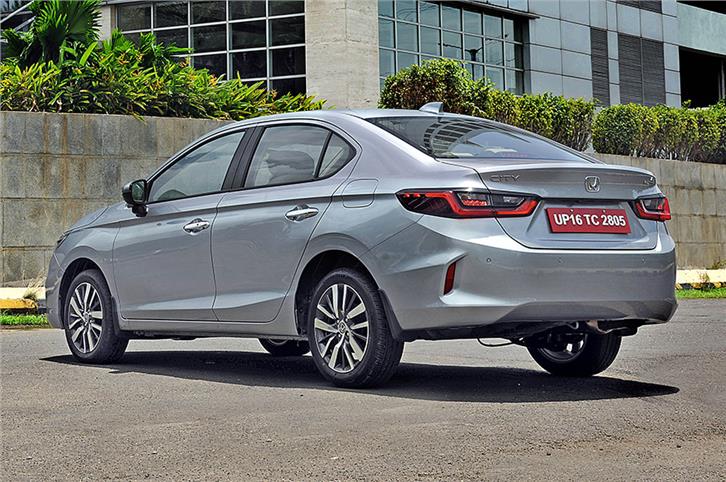
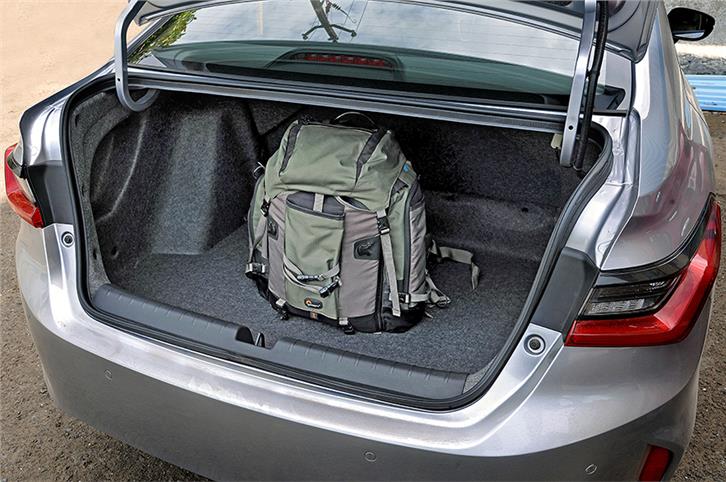
Boot is large at 506 litres; weak torsion springs do not lift the lid at all.

We Like
- Best in class comfort
- Strong and tractable engines
- Well equipped
We Don't Like
- Not as sporty as we would have liked
- Touchscreen difficult to read
What is it?
SUVs may rule the roost today, but the City, even 22 years on, is still alive and kicking, and is one of the longest-running nameplates currently on sale in India. The City’s India story began in 1998 and we’ve had four versions since. The first three cars were all very unique in character, with each model being a success for Honda.
Uncharacteristically then, the 4th-generation was more of an evolution, but thanks to the further improvements and introduction of a diesel option, it went on to become the most successful City in India, and it’s this very evolutionary approach that's been carried forward to the 5th-gen City.
Don’t think for a moment though that it's a simple update of the previous car. While it is based on a modified version of the earlier City, the engineering changes are massive. The new City’s body shell packs in more high-tensile-strength steel and a stiffer roof section, resulting in a 20 percent increase in torsional rigidity. The body shell is marginally lighter too, but the overall weight of the car is up by around 40kg thanks to other enhancements like a firewall that is 200 percent thicker aiding stiffness, safety and sound insulation.
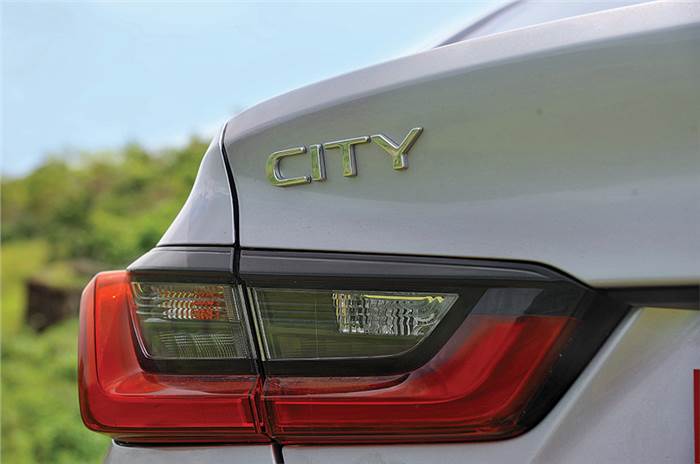
The City has also grown in size, offering a little more interior space, and it’s got more tech like a lane watch camera and Alexa voice assistant integration. On the powertrain front, the petrol motor is a new DOHC 1.5-litre unit that’s now coupled to a 6-speed manual gearbox. CVT is still an option. The older City’s 1.5 diesel and 6-speed manual carry forward too, but with some modifications to improve refinement and, of course, meet BS6 emission norms.
The new City won’t have it easy though. Action in the midsize sedan segment has certainly hotted up; in a short a span of just a few weeks we’ve seen Skoda update its Rapid, as did VW its Vento, while Hyundai gave the Verna a major overhaul. The Ciaz continues to be a strong player too. So can the new City leapfrog all its rivals?
What’s it like on the outside?
The City looks more of an evolution of the previous model and the overall stance, shape and design of the individual elements remind you of the earlier car. While the wheelbase is the same as before (as this platform shares a lot of the hardpoints with the previous-gen), the new car has grown a fair bit in length and width, though the height is less than before.
Honda’s signature front chrome bar is now thicker with the top strip stretching across the width of the nose, above the LED highlights. The sharp-looking headlights with their multiple reflectors and techy detailing look brilliant, and make the new City stand out as genuinely new.

It’s from the side that you get a good idea of the new City’s enormous length, which at 4,549mm, makes it not just longer than every other midsizer but even longer than the first-gen Civic! Yes, the City which is equally appreciated for its front and back seats, has grown with each successive generation. However, with no corresponding increase in wheelbase over the previous car, the proportions have slightly gone for a toss. The long, high bonnet and chunky bumper make the car look more grown-up than before, but the nose sticks out quite a bit, resulting in a front overhang that’s a touch excessive.
This dwarfs the smart 16-inch looking alloys shod with 185/55 tyres which don’t quite fill out the wheel arches. The earlier car’s shoulder line has been moved higher up and it runs the length of the car, and this, along with the sharp crease across the bottom of the doors, gives a nice tension to the body.

The 3D-looking tail-lights are also very striking and the blacked-out elements look very neat. What also stands out are the vertical reflector strips that sit inside a sculpted housing in the rear bumper. On the whole, though, this isn’t a car that will turn heads easily but it’s neatly designed and looks quite contemporary.
What’s it like inside?
Open the doors and you’re greeted by a premium-looking, light brown and black interior. The plastics around the cabin also look good but they are a bit too shiny; we would have preferred duller, soft-touch textures. This aside, there’s little else to complain about. Honda has been generous with the use of light brown leather; it's on the seats, door trims, dash panel and the centre console too, and it really does add to the rich feel inside. The dash and centre console trim are beautifully styled with neat stitching and the well-sculpted seats look very inviting. They are comfortable with good all-round bolstering, but if I had to nitpick, the lower lumbar support is a bit excessive on the front and rear seats.
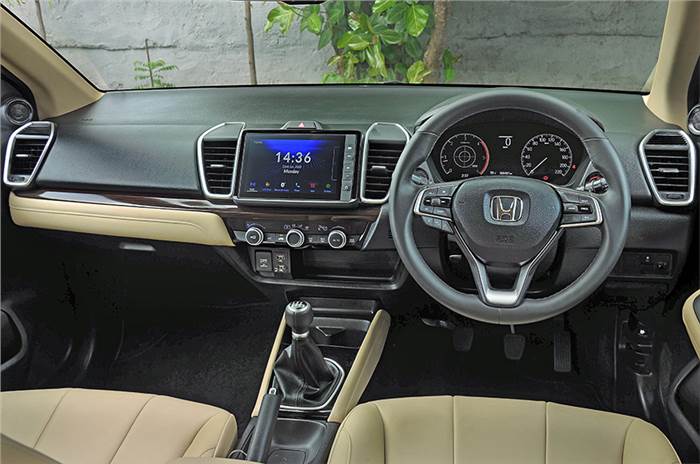
Honda aced backseat comfort with the 4th-gen City, and has done it yet again with a rear bench that's the most generous in the class. The wide and deep seat base, positioned at the right height, will keep you comfortable for hours on the road. Like before, the small rise in the floor behind the front seat, acts as a natural footrest which further enhances comfort levels. What’s nice is that all three rear passengers get three-point seat belts and properly sized head restraints. However, headroom at the back was just about sufficient for my 5ft 8in frame; I had a three-finger gap to the top, which means taller folks may find it tight.
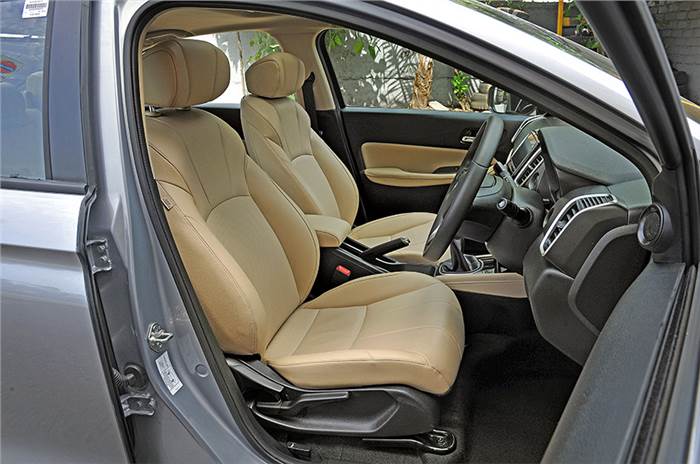
There’s plenty of the usual storage spaces around but what’s really clever are the ones for phones. Front passengers have two slots on either side of the parking brake lever, while those at the rear have handy felt-lined pockets sewn into the front seatbacks. Boot space has gone down by a tiny 4 litres and is now at 506 litres; so it’s still very large and useable.

The boot-opening mechanism uses torsion rods which act as elastic springs to lift the boot lid, but they aren’t strong enough; so the lid doesn’t pop open on its own and you have to lift it all the way to the top.
How about equipment?
Hondas aren't typically what you’d call well-equipped, this City, however, is quite different. There’s a lot of equipment including a sunroof, a lane watch camera, a rear-view camera with normal, wide and top view, a tyre pressure monitoring system with deflation warning, front side and curtain airbags, and auto climate control that thankfully doesn't get touch-operated buttons but neat knurled knobs that have a nice click to them; this means you don’t have to take your eyes off the road to use the controls. The steering wheel too has controls including a roller switch that lets you access various features of the instrument panel.

The instrument panel itself consists of an analogue speedometer needle that runs across a digital dial on the 7.0-inch screen. The tachometer is an all-digital display and the screen can also display a G-force meter, and other trip-related info. The design of instrument panel display is quite simple but its clarity is brilliant and isn't distracting like in the Verna. The bright and sharp instrument cluster is incredibly easy to read, however, the same cannot be said of the 8.0-inch touchscreen.

Honda says it has used an optical bonding application that reduces reflection but the trouble is that this coating has seriously reduced the brightness of the screen. Even on the brightest setting, the screen is difficult to read in direct sunlight, and it always looks smudgy like it could use a good wipe down. The system, of course, has all the usual connectivity bits including Android Auto and Apple CarPlay.
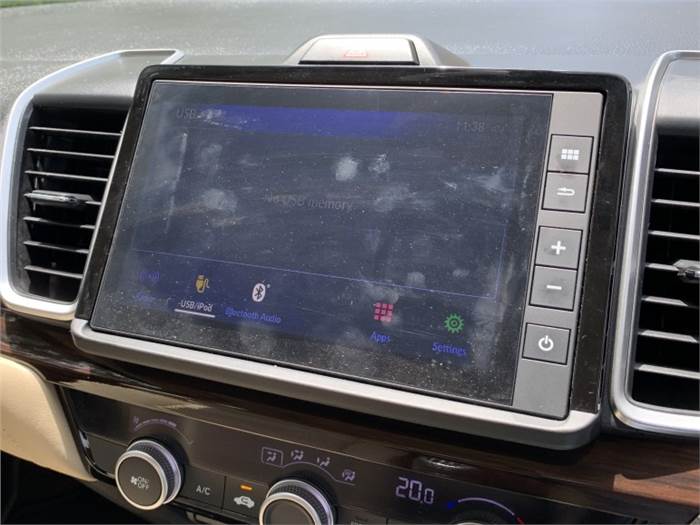
Also on the 5th-gen City is a new version of Honda’s connectivity tech that gets you all the regular bits like remote engine start, pre-cooling, but the party trick here is the Alexa voice assistant integration. So, from your home, you can simply ask Alexa to pre-cool the cabin or get you details of the fuel level in the car or its current position.
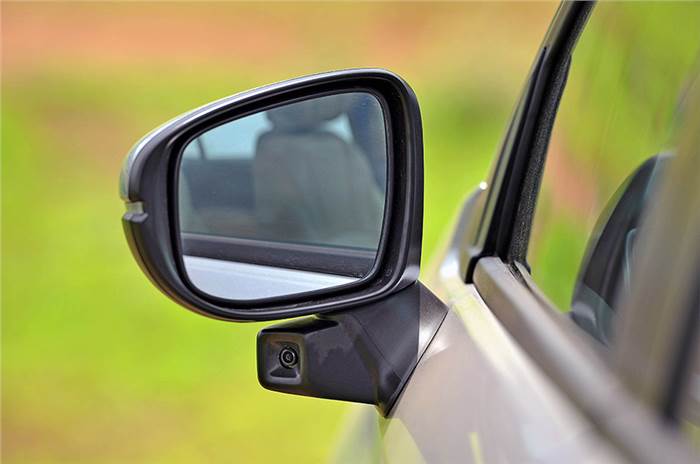
What’s it like to drive?
If there’s one high point of a Honda, it’s the engine; and it’s the same here with the new DOHC 1.5-litre petrol which is a real delight. It’s not punchy like a turbo unit but it’s very strong and tractable and works well at both ends of the rev range. At low revs, it pulls cleanly even in higher gears, and it revs freely until the 7,000rpm redline. Compared to the older car, gear ratios are a bit taller here, letting you hit higher speeds in each gear, but what’s good is that the motor is flexible enough to deliver great performance all throughout. This tractability allows you to drive right from 15kph all the way past 150kph in 3rd! This means you’ll have fewer gears shifts to contend with. Honda claims a fuel efficiency of 17.8 for the manual and 18.4kpl for the auto, which is marginally higher than the earlier car's SOHC motor which delivered 17.4 and 18.0kpl, respectively.

The new engine does get audible at around 3,000rpm but it’s not harsh just loud. It’s also pretty potent too; the City hits 100kph from a standstill in 10.20sec, which is just 0.07sec off the earlier car's time, and only marginally behind Skoda’s turbocharged 1.0 TSI Rapid time of 10.09sec.
Taller ratios also mean in-gear times are slower. 20-80kph in 3rd comes up in 13.23sec, while 40-100kph in 4th takes 18.23sec.The Rapid 1.0 TSI clocks 11.69 and 14.38 sec, respectively.
Coupled to the CVT, the City does 0-100kph in 12.05sec. Although slower, it still will be acceptable for most, and you’ll also have the benefit of an automatic kickdown during in-gear acceleration which showed a time of 6.58sec in 20-80kph, and 8.52sec in the 40-100kph dash.
| 2020 Honda City performance figures (as tested) | ||||
|---|---|---|---|---|
| Petrol MT | Petrol CVT* | Diesel MT* | ||
| 0-20kph | 1.17sec | 1.45sec | 1.17sec | |
| 0-40kph | 2.74sec | 3.39sec | 2.97sec | |
| 0-60kph | 4.53sec | 5.54sec | 5.30sec | |
| 0-80kph | 7.22sec | 8.38sec | 8.64sec | |
| 0-100kph | 10.20sec | 12.05sec | 12.90sec | |
| 0-120kph | 14.98sec | 16.69sec | 18.26sec | |
| 0-140kph | 20.71sec | 24.30sec | 27.05sec | |
| 20-80kph | 13.23sec | 6.58sec** | 11.40sec | |
| 40-100kph | 18.23sec | 8.52sec** | 13.89sec | |
*Tests not to Autocar India standards, **acceleration in kickdown
What’s nice is that the typical rubberband effect of the CVT is very well managed. For most everyday driving situations, the rise in revs matches the rise in road speed and it's only when you mash down on the accelerator that you get the typically stretchy feel, with the revs climbing faster than the actual road speed. Plus, of course, you can also use the paddles and have proper manual control over shifts with the 'box letting you redline the engine too.
Honda says it has calibrated the control unit's software, and it uses what the company calls 'full-open acceleration step-up shift control' and 'brake operation step-down shift control. Quite a mouthful, yes, but what this does is, during acceleration, rather than let the CVT slide its way up, it performs stepped upshifts and tries to match the vehicle speed with the engine speed and sound. And under hard braking, the CVT shifts to much lower ratios thus providing engine braking; this is something we saw put into effect when driving down a winding road.
If you’ve read our past reviews of the City diesel, or even cars like the Amaze that use the same 1.5 diesel, you’ll know we haven’t been fans of the refinement levels. However, Honda has worked to improve NVH levels on the new City, utilising bits like additional sound deadeners in the floor, a thicker firewall, and by also spraying the engine bay with a special sound-deadening coating. The result is an engine that’s noticeably quieter and pleasantly refined. At low revs, this motor doesn't get obtrusive, and that annoying, sharp diesel clatter that characterised the previous iterations is all but eliminated. Yes, the engine drones loudly at high revs, and, in absolute terms, isn't as quiet as Hyundai’s 1.5 diesel, which is still the benchmark for refinement.
| 2020 Honda City petrol noise levels (as tested) | |
|---|---|
| Idle with AC off | 39.4dB |
| Idle with AC blower at half | 51.7dB |
| Idle with AC blower at full | 64.5dB |
| 50kph in 4th gear | 64.5dB |
| 80kph in 6th gear | 69dB |
| Full revs at redline in 1st gear | 78.2dB at 7000rpm |
The diesel also surprised us with its un-diesel-like power delivery. It’s pretty tractable from low revs and turbo lag is quite minimal too. Sure, at low revs, below 1,500rpm, the power is muted, but you don’t really struggle with a lack of response. And when you cross the 1,500rpm, it's not a sudden spike but a quick step up in pace, after which power builds quite evenly all the way to 4,200rpm soft rev limiter. The diesel posts a 0-100kph time of 12.9sec, while 20-80kph in 3rd and 40-100kph in 4th are much quicker than the petrol, with 11.4 and 13.89sec, respectively. As with many BS6 updates, fuel efficiency has dropped, the new unit returning 24.1kpl as against the previous 25.6kpl. Honda has used a NOx Storage Catalyst (NSC), thus avoiding the use of the AdBlue liquid that SCR systems need. The penalty for this, of course, is the slight drop in efficiency, which is due to the extra fuel being used for exhaust after-treatment.
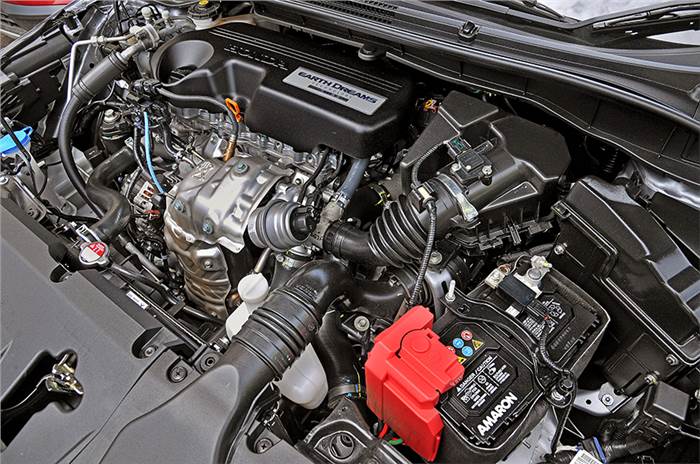
What’s the ride and handling like?
Thanks to the stiffer body, Honda says it's been able to go softer with the suspension, and this has certainly helped the ride. The City absorbs whatever the road throws at it and it soaks up potholes and ruts without crashing through them. The ride is quite mature in feel, much like what you’d expect from European sedans. It’s also flat and composed at highway speeds, but if you press on to higher three-digit speeds, with the speedo needle sitting in the last quadrant of the dial, the City, which has a relatively high ground clearance, is not as planted as we would have liked. You need to have a firm grip on the wheel as the nose tends to wander.
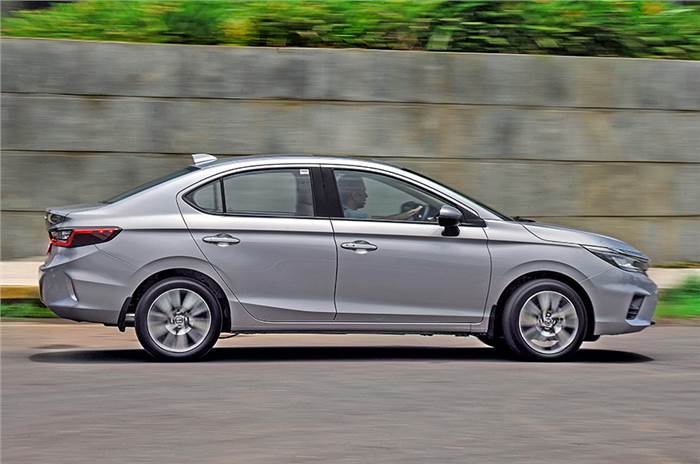
Handling, however, is benign and very predictable, which makes the City an easy car to drive. The steering is nicely weighted and the grip from the tyres is surprisingly good and could tempt you to have some fun, especially when you have a rev-happy, naturally-aspirated engine that’s always ready to play ball. But, if you push too hard, the soft-suspension will give way to a fair bit of body roll, which is more pronounced in the front.
Braking performance is good, however an earlier bite point and a less spongy pedal feel would've helped. All in all, this is a car that will reward all but the keenest of drivers.
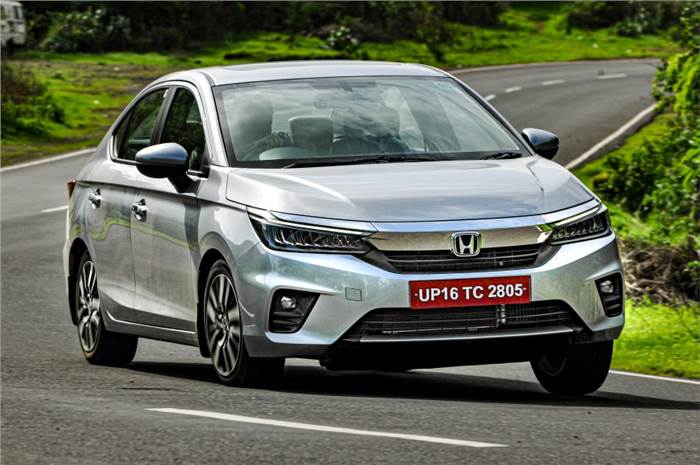
Should you buy one?
The new City may not look all that new and it doesn’t deviate from the tried and tested formula of its predecessors. The handling isn’t sporty either, and the chassis setup doesn’t quite match the enthusiasm of the rev-happy petrol, and that may disappoint keen drivers. But there’s little else to fault with Honda’s latest midsize sedan and it scores where it matters most. Space and overall comfort are the best in class, the practical cabin with lots of thoughtful touches looks very premium, and, for a change, it’s very well specced with some neat party tricks like the Alexa integration. Both engines are strong and deliver a solid performance, and the ride is very well sorted too.
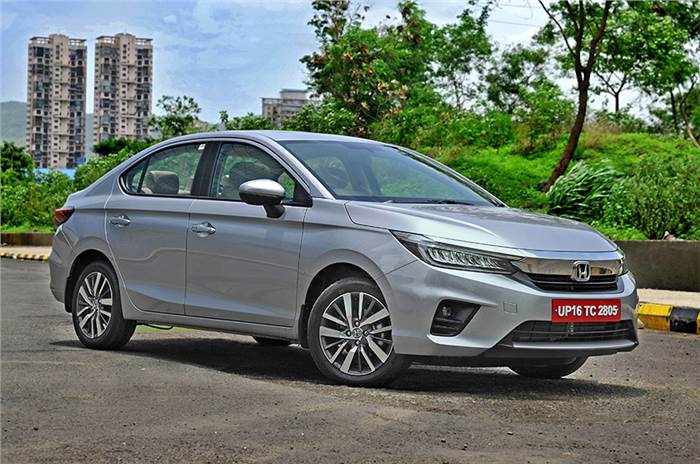
On the whole, Honda has done a tremendous job with the new City, and it looks all set to leapfrog the competition. A hurdle, though, could be its pricing. Starting at Rs 10.90 lakh (ex-showroom, Delhi) for the petrol, the new City is a good Rs 1.6 lakh pricier than the base Hyundai Verna, with the top-spec manual costing Rs 55,000 over the Verna that’s similarly equipped, if not better. On the diesel front, where only these two brands have an offering, the City is also pricier at the base by Rs 1.74 lakh and at the top by Rs 70,000.
Of course, Honda will have the current City also on sale but going by current prices, that version too begins above the updated Verna. Thus, Honda really has their work cut out and time will tell if the Japanese brand leapfrogs the competition or leaps out of the segment and contention. But as the company says, in India, Honda means the City, and so if there is one brand and one model that can command this premium, it would be the Honda City.
Also see:
2020 Skoda Rapid 1.0 TSI review, test drive
2020 Hyundai Verna review, test drive
Tech Specs 
Copyright (c) Autocar India. All rights reserved.





 Engine
Engine Transmission
Transmission Acceleration
Acceleration Noise Level
Noise Level Body
Body Suspension
Suspension Steering
Steering Brakes
Brakes Dimensions
Dimensions
Comments
Member Login
Personal Details
No comments yet. Be the first to comment.